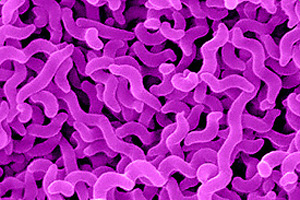Research: Indirect transmission of C. jejuni between broilers

Infectious diseases in plants, animals and humans are often transmitted indirectly between hosts (or between groups of hosts), i.e. via some route through the environment instead of via direct contacts between these hosts. A recent study examined indirect transmission experimentally, using transmission of Campylobacter jejuni (C. jejuni) between spatially separated broilers as a model system.
Three stages in the process of indirect transmission were distinguished; (1) an infectious “sender” excretes the agent, after which (2) the agent is transported via some route to a susceptible “receiver”, and subsequently (3) the receiver becomes colonised by the agent. The role of the sender and receiver side (stage 1 and stage 3) was studied here by using acidification of the drinking water as a modulation mechanism.
In the experiment one control group and three treatment groups were monitored for the presence of C. jejuni by taking daily cloacal swabs. The three treatments consisted of acidification of the drinking water of the inoculated animals (the senders), acidification of the drinking water of the susceptible animals (the receivers) or acidification of the drinking water of both inoculated and susceptible animals. In the control group 12 animals got colonised out of a possible 40, in each treatment groups 3 animals out of a possible 40 were found colonised with C. jejuni.
The results of the experiments show a significant decrease in transmission rate (beta) between the control group and treatments group (p < 0.01 for all groups) but not between different treatments; there is a significant negative interaction effect when both the sender and the receiver group receive acidified drinking water (p = 0.01). This negative interaction effect could be due to selection of bacteria already at the sender side thereby diminishing the effect of acidification at the receiver side.
Source: BMC Veterinary Research













